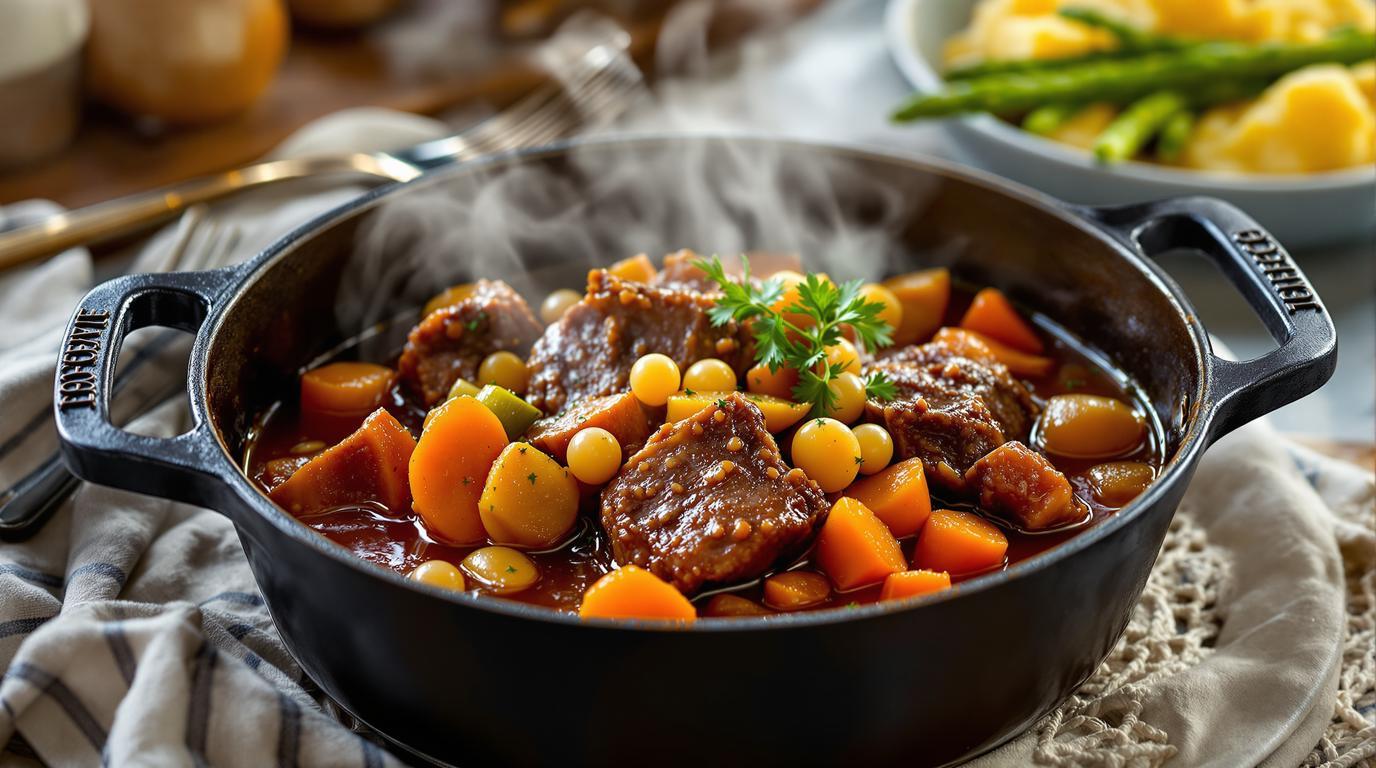The first time I made oxtail stew was during my apprenticeship in London. My mentor, Chef Harrison, insisted I master this humble dish before attempting anything fancier. “This is how we judge a real chef,” he told me, watching as I nervously trimmed the unfamiliar cuts. Twenty years later, I still remember the moment that rich, wine-infused aroma filled the kitchen, signaling transformation of a once-overlooked cut into something magnificent. This slow-cooked oxtail stew represents everything I love about classical cuisine—patience rewarded with profound flavor and melt-in-your-mouth texture.
The Humble Origins of Oxtail Stew
Oxtail stew has fascinating roots in British cuisine, though today you’ll find beloved variations across the Caribbean and American South. Originally a thrifty dish from the 1800s when working-class families utilized every part of the animal, this cut has since earned its place on fine-dining menus worldwide. What makes oxtail special is its perfect balance of lean meat, collagen-rich connective tissue, and marrow that dissolves during slow cooking to create an incomparably silky sauce. The same principle works beautifully in dishes like Hoppin’ John, where time transforms humble ingredients into something extraordinary.
Essential Ingredients
For this classic preparation (serves 4), you’ll need:
- 2.5-3 pounds (1.2-1.4kg) oxtail pieces, preferably trimmed
- 2 tablespoons (30ml) olive oil or beef dripping
- 1 tablespoon (15g) all-purpose flour
- 1½ cups (375ml) dry red wine (Cabernet Sauvignon works beautifully)
- 2 medium onions, roughly chopped
- 4 celery stalks, diced
- 3 carrots, chunked
- 4 garlic cloves, smashed
- 2 bay leaves
- ½ teaspoon dried herbs (thyme, rosemary, oregano blend)
- 3 tablespoons (45g) tomato paste
- 1¼ cups (300ml) beef stock
- Salt and freshly ground black pepper
The Method: Patience Rewarded
Oxtail demands time, but the process itself is straightforward:
- Preheat your oven to 325°F (170°C). Season the oxtail pieces generously with salt and pepper, then dust lightly with flour.
- In a heavy-bottomed Dutch oven, heat the oil until shimmering. Working in batches to avoid crowding, sear the oxtail pieces until deeply browned on all sides, about 3-4 minutes per side. This isn’t just for color—it’s creating the foundation of flavor through the Maillard reaction. Remove and set aside.
- In the same pot, add onions and celery, cooking until softened, about 4 minutes. Add carrots and garlic, cooking 2 minutes more.
- Add tomato paste and cook for 1 minute until it darkens slightly. This brief caramelization removes raw tomato flavor and adds depth.
- Pour in the red wine and bring to a vigorous simmer, scraping the bottom thoroughly with a wooden spoon to release all those wonderful browned bits (deglazing). Reduce wine by half.
- Return the oxtail to the pot. Add beef stock, bay leaves, and herbs. The liquid should come about ¾ up the sides of the meat—not completely submerging it.
- Cover tightly and transfer to the oven. Cook for 3 hours, until the meat is falling-off-the-bone tender.
Chef’s Note: The magic of oxtail happens between hours 2 and 3, when the collagen fully converts to gelatin. If you check at 2 hours and the meat resists when pulled with a fork, be patient and continue cooking. This isn’t something you can rush—like the transformation in slow-braised pork belly, the reward comes to those who wait.
Regional Variations Worth Exploring
While this recipe follows the British tradition, Jamaican oxtail offers a brilliant variation. For a Caribbean twist, marinate your oxtail overnight with 1 tablespoon curry powder, ½ Scotch bonnet pepper (whole), and 1 teaspoon allspice. Substitute dark stout beer for half the wine for authentic island flavor. This approach creates a completely different but equally magnificent dish, much as traditional Indian spices transform humble ingredients into complex flavor profiles.
Serving the Masterpiece
I prefer serving oxtail in shallow bowls nestled alongside buttery mashed potatoes that can capture the rich sauce. A side of simply steamed green vegetables provides welcome brightness. For wine pairing, continue with what you used in cooking—a robust Cabernet Sauvignon or earthy Bordeaux blend harmonizes beautifully with the dish. In summer months, consider serving alongside grilled peaches with burrata for an unexpected but delightful contrast.
Oxtail symbolizes everything wonderful about traditional cooking—transforming something overlooked into something magnificent through patience and technique. Just as Depression-era banana bread teaches us about resourcefulness, this dish reminds us that the most humble ingredients often yield the most profound flavors. Make this on a quiet Sunday when you can enjoy the gradually intensifying aromas filling your home, and I promise the three-hour wait will be richly rewarded at the table.
